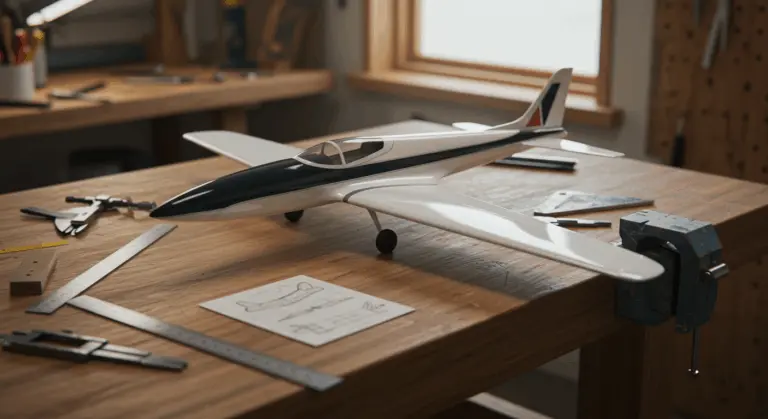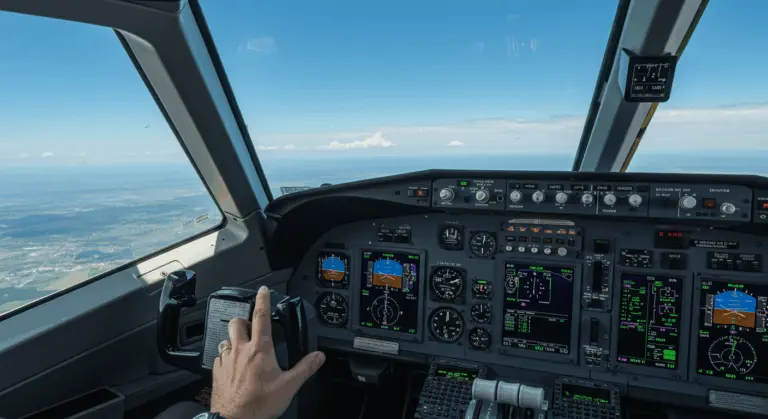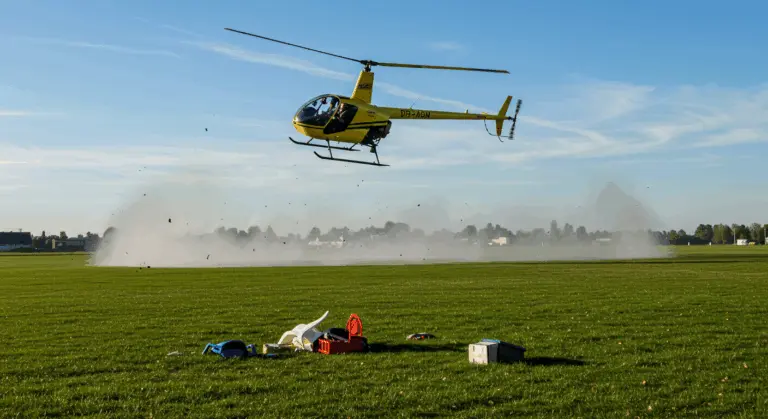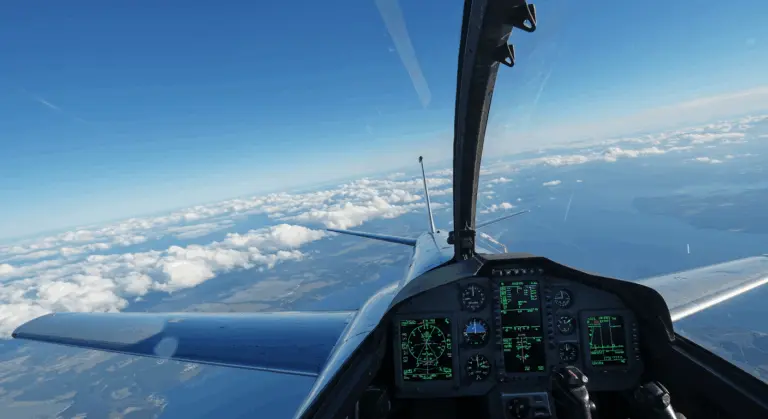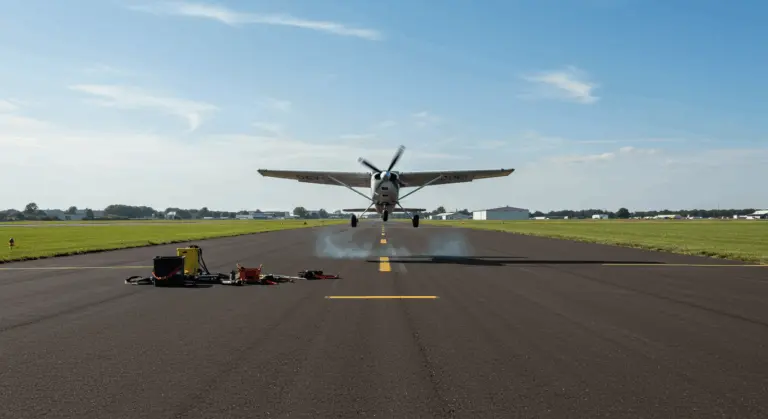Understanding Wingtip Vortices – Causes, Effects, and Management
What Are Wing tip Vortices?
Wing tip vortices are fascinating spirals of rotating air that trail behind aircraft wings during flight. Contrary to their name, these swirling air masses don’t originate precisely at the wing tips but form slightly inboard. They represent one of aviation’s most intriguing and significant aerodynamic phenomena.
These vortices emerge as an inevitable consequence of lift generation. When air spills around the wing tip—driven by the pressure difference between the wing’s high-pressure lower surface and low-pressure upper surface—it creates a trailing spiral known as a lift-induced vortex.
Wing tip vortex formation physically manifests induced drag—an inescapable byproduct of three-dimensional lift generation. These spiraling masses represent energy loss—expended by the aircraft without contributing to propulsion or lift. This lost energy creates rotational flow patterns that can linger in the atmosphere long after the aircraft has vanished.
Between the pair of counter-rotating vortices trailing behind an aircraft lies a region of downwash—air being forced downward. This downwash alters the wing’s effective angle of attack, diminishing its efficiency and amplifying the aircraft’s overall drag burden.
How Are Wing tip Vortices Formed?
Wing tip vortex formation stems from lift generation’s fundamental principle. As an aircraft moves through the air, the wing creates a pressure differential—lower pressure above the wing and higher pressure below. This pressure difference doesn’t simply vanish at the wing tip. Instead, high-pressure air beneath the wing seeks the lower-pressure region above, curling around the wing tip as it flows.
This curling motion creates a rotational flow that evolves into the wing tip vortex’s characteristic spiral signature. The process is continuous during flight, with new air constantly being entrained into the vortex system. The phenomenon intensifies dramatically during high angle-of-attack operations—takeoff, landing, or slow flight—when the pressure differential between wing surfaces reaches its peak.
Vortex formation can also be understood by examining the wing’s trailing edge dynamics. Here, air streams from above and below converge at sharp angles, creating a shear layer that naturally rolls up into rotating vortices. These vortices migrate outward toward the wing tips, where they consolidate into the powerful trailing vortices we observe.
Once rotation commences, it persists through angular momentum conservation—the same principle sustaining a spinning top. This self-sustaining nature of vortices explains why they can remain intact in the atmosphere for extended periods, sometimes several minutes after a large aircraft has passed.
Effects of Wing tip Vortices on Aircraft
Wing tip vortices impose their main cost through induced drag. This aerodynamic penalty diminishes aircraft efficiency, demanding additional power to sustain flight and consequently inflating fuel consumption while constraining operational range.
For trailing aircraft, these vortices present a serious hazard: wake turbulence. An encounter can trigger violent rolling moments that may overwhelm pilot control inputs—a danger greatly increased for smaller aircraft.
These atmospheric vortices follow predictable behavioral patterns that pilots must master. After formation, vortices typically descend behind the generating aircraft at a rate of several hundred feet per minute until they either dissipate or reach ground level. Near the ground, they tend to move laterally, especially in windy conditions. This explains why wake turbulence strikes not directly astern but laterally offset—especially pronounced in crosswind conditions.
Visibility of Wing tip Vortices
Under specific atmospheric conditions, wing tip vortices become visible to observers—providing a unique glimpse of normally invisible aerodynamic forces. The visibility occurs primarily due to condensation within the low-pressure cores of the vortices. As pressure plummets within the vortex core, temperature follows suit—sometimes dramatically. If this temperature falls below the dew point of the surrounding air, water vapor condenses into visible water droplets or, in very cold conditions, ice crystals.
This visible effect appears most readily on humid days when moisture-laden air provides the raw material. It’s particularly noticeable during high-angle-of-attack maneuvers such as takeoffs, landings, or tight turns, when the pressure differential—and consequently the vortex strength—is at its maximum. The result? Spectacular condensation trails spiraling behind wing tips, sometimes stretching across remarkable distances.
Military demonstrations and air shows intentionally use this phenomenon, executing high-G maneuvers when atmospheric conditions align perfectly. Commercial aircraft can also produce visible vortices during takeoff and landing in humid environments. For aviation photographers and enthusiasts, capturing these visible vortices offers an excellent chance, as they reveal the invisible aerodynamic forces at work.
While visually striking, vortex visibility bears no reliable correlation to strength or danger. Powerful vortices can remain completely invisible in dry conditions, while relatively moderate vortices might be dramatically visible in high humidity. Pilots must never depend solely on visual cues when assessing wake turbulence presence or intensity.
Hazards Associated with Wing tip Vortices
Wake turbulence encounters can cause sudden, violent rolling moments on aircraft—particularly devastating when smaller aircraft trail larger ones. This rolling force can overwhelm the affected aircraft’s control authority, potentially triggering loss of control at altitudes too low for recovery. The threat peaks during critical takeoff and landing phases.
Several factors amplify this danger:
-
Persistence: Vortices can remain intact for several minutes in calm air.
-
Movement: They tend to sink and drift with the wind, potentially moving into the flight path of a following aircraft.
-
Strength: The most powerful vortices are generated by heavy aircraft flying slowly in a clean configuration.
Wake turbulence encounters have claimed numerous aircraft in accidents and incidents. In one notable case, a business jet encountered the wake of a larger aircraft and experienced an uncontrollable roll, resulting in a fatal crash. These tragedies spurred development of weight-based aircraft separation procedures in air traffic control.
Beyond immediate safety threats, wake encounters cause considerable structural stress on aircraft components—especially wings and control surfaces. Even when pilots successfully maintain control during a wake encounter, the sudden forces experienced may necessitate special inspections to ensure no damage has occurred. For passengers, these encounters prove extremely unsettling and frightening, even when expertly managed by flight crews.
Wing tip Devices for Vortex Control
Aircraft manufacturers have developed numerous wing tip devices designed to address vortex formation and strength mitigation. These devices serve the dual purpose of reducing induced drag (thereby improving fuel efficiency) and potentially decreasing the hazards associated with wake turbulence. These devices operate by reshaping wing tip pressure distribution, fundamentally altering vortex formation mechanisms.
Passive wing tip devices are the most common approach. Popular variants include:
-
Winglets: Vertical extensions that increase the wing’s effective aspect ratio. Variations include blended and split-scimitar winglets.
-
Raked Wing tips: Tips that sweep backward to extend the wing’s span.
-
End plates & Fences: Small vertical surfaces designed to disrupt the circular airflow.
-
Specialized Tips: Other designs include Horner-style tips, spiroid, and experimental porous or slotted tips that diffuse the vortex.
Active control systems—like synthetic jet wing tips—represent emerging technology but remain uncommon due to complexity and weight penalties. Crucially, while wing tip devices reduce vortex strength, the reduction never justifies relaxing separation standards. Pilots must maintain all standard avoidance procedures.
Factors Influencing Vortex Strength
Aircraft weight is the main factor determining of vortex strength. Heavier aircraft must generate more lift to maintain flight, which creates stronger pressure differentials around the wings and consequently more powerful vortices. This explains why wake turbulence separation categories hinge on weight classifications—with super-heavy aircraft like the Airbus A380 demanding special consideration.
Airspeed significantly affects vortex intensity—slower speeds typically create stronger vortices. This occurs because at lower speeds, an aircraft must fly at a higher angle of attack to generate sufficient lift, increasing the pressure differential between the upper and lower wing surfaces. This relationship explains why landing-configured aircraft, flying at reduced speeds, generate particularly treacherous wake turbulence.
Wing design characteristics significantly affect vortex formation. Aircraft with shorter, wider wings (low aspect ratio) tend to produce stronger vortices than those with long, narrow wings (high aspect ratio). Wing loading—the weight supported per unit area of wing—directly correlates with vortex strength. Furthermore, configuration elements like deployed flaps can reshape vortex structure, occasionally spawning multiple vortex pairs with intricate interactions.
Atmospheric conditions dictate vortex persistence after formation. In still air, vortices can remain intact for several minutes, while turbulent conditions tend to break them up more quickly. Ground effect—aerodynamic interaction between wing and earth at low altitude—can redirect vortex behavior, forcing lateral movement rather than continued descent. These factors combine to create a complex picture of vortex behavior that pilots must consider when operating in potentially affected airspace.
How to Avoid Wing tip Vortices
Avoiding wing tip vortex hazards requires careful adherence to procedures, situational awareness, and deep understanding of vortex behavior. For pilots, the first line of defense is adherence to established separation standards. Air traffic control enforces specific separation requirements based on aircraft weight categories, but pilots must recognize these as minimum standards—often requiring expansion under certain conditions.
Multiple strategies can minimize wake turbulence exposure during takeoff. When following a larger aircraft, pilots should rotate before the preceding aircraft’s rotation point and climb above its flight path. When departing from runway intersections rather than the threshold, pilots must consider where preceding aircraft rotated—vortices may still lurk at that precise location. In crosswind conditions, positioning on the upwind side of the runway can help avoid vortices that drift across the runway.
Landing operations follow similar principles. Staying at or above the preceding aircraft’s approach path and landing beyond its touchdown point helps avoid the descending vortices. In crosswind conditions, vortices drift from the runway centerline, potentially positioning themselves directly within the downwind approach path. Pilots should adjust their approach accordingly or request a different runway if conditions warrant.
When wake turbulence becomes unavoidable, pilots must prepare to counteract its effects. This includes maintaining a firm grip on flight controls, being ready to apply maximum control inputs if necessary, and having sufficient airspeed to ensure control effectiveness. Should severely encounter appear imminent during approach, executing a go-around remains the safest option. For departures, having an escape strategy that includes climbing above or turning away from the expected vortex location may prevent accidents. Sometimes, waiting is the best approach. Simply waiting a few additional minutes for vortex dissipation can eliminate the hazard entirely.
Conclusion: Understanding and Managing Wing tip Vortices
The aviation industry has crafted a multi-layered defense against these risks:
-
Aircraft Design: Implementing wing tip devices to reduce vortex strength and improve fuel efficiency.
-
Air Traffic Management: Enforcing separation standards based on aircraft weight categories.
-
Pilot Procedures: Using specific takeoff and landing techniques to avoid wake turbulence zones.


